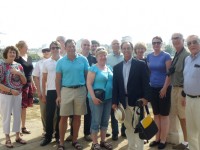By Roger Kallman
This year the Institute embarked on a new experiment, bringing together Members of the Board and Friends of the Institute, on a specially organized trip to Cuba which not only provided an exceptional programme, but which also served to raise additional funds to support the work of the Institute. Led by Frank Vigier, President of I2UD, and supported by Mary Shia, twelve intrepid individuals spent eight fascinating days in Havana, Trinidad and Cienfuego and in the countryside which links them.
The trip provided a unique opportunity to experience this country, at a pivotal moment in its history, as it moves through political and economic changes which will have a profound impact on the future of its cities. Guided by leading Cuban architect, academic and urbanist, Julio Cesar Peres Hernandez, we toured both historic and contemporary examples of significant town planning and architectural design which have shaped the physical appearance and the character of those cities.
We explored the historic quarters of all three places which have been recognized by UNESCO as World Heritage Sites, and we enjoyed the opportunity to speak with specialists involved in their restoration. But in Havana, uniquely, we were able to trace the evolution of a major city over five centuries as it was transformed from what was initially a colonial outpost to the political and commercial hub of the Caribbean. We walked the esplanade, the Malécon, and the parks and plazas which give the city form, and viewed and toured many of the buildings which serve to define those spaces. The architecture of these structures ranges in style from Creole and Classical to Art Nouveau and Art Deco, but occasional examples of Modernist design emerge in sometimes unexpected places.
Within Havana, the names of the squares often gave clues as to their functions: Plaza Vieja, Plaza de San Francisco, Plaza de Armas and Plaza de la Catedral. But few hints were given as to their character – their scale, proportion and orientation. These were only revealed on closer inspection, which rewarded our efforts. As the city expanded in a westerly direction, new elements of urban design were added to the fabric of the city: the Paseo de Marti or Prado, as grand as its namesake in Spain, and the Parque Central, beside the national parliament building. Further westward, the Cementarlo Cristobal Colon, the City of the Dead within the City of the Living is without comparison in any other western city, save perhaps for Buenos Aires. Outside and to the south of Havana we visited Parque Lenin, an enormous new open space and joint Soviet/Cuban effort, at the heart of which we found the delightful “Las Ruinas”, an exquisite mixture of contemporary design and the remnants of an 18th c sugar mill.
Havana began its eastward expansion across the Canal de Entrada which separates it from La Habana Vieja, the historic heart of the city. We toured East Havana in order to examine examples of new residential districts – Soviet style housing estates which represent the bulk of residential projects created during the last fifty years. These were built after the 1959 Revolution, to accommodate the surge in population growth, brought about both by natural increase and unprecedented immigration from the provinces. While master planned and designed in line with similar projects elsewhere in the world, these housing estates were inevitably beset by problems related to social planning, finance, management and construction.
While East Havana stands in marked contrast to much of the rest of the city, this experiment with an alternative housing format is not without its merits. It has the potential to be renewed much like the housing stock in other areas, and this can be accomplished through a combination of structural changes and selective interventions. Whatever other benefits may be attributed to these housing projects, perhaps the most important is that they relieved established areas from the pressure of wide-scale urban renewal which could have cost Havana much of its character as well as its architectural heritage.
A range of social and cultural experiences rounded out our program in Cuba. Particularly memorable was an evening in Havana spent at the Gran Teatro where we attended a performance of the world-renowned, National Ballet of Cuba. No less impressive, however, was a choir performance in Cienfuegos, performed, perfectly, in an almost austere environment, in the otherwise ornate Palacio de Valle. Wonderful lunches and dinners featured in our program as well, affording us the opportunity to experience Cuban cuisine – both traditional and contemporary. Particularly memorable was dinner in a paladar in Centro Habana, the remarkable La Guarida. The restaurant is famous for the building in which it is situated – the setting for the notable Cuban film, “Fresa y Chocolate” – but it is also distinguished for the imaginative style of its progressive method of cooking.
Our visit to Cuba began and ended in the enigmatic city of Havana, but the knowledge we have acquired, and the impressions we have formed, reflect our experience gained throughout the country.
See photos.
Discovering Cuba

